- Simple LED Flasher - Simple LED flasher by using Nutchip.
- AC Powered LED Schematic - Light up LED by using AC supply.
- LED Chaser - Simple LED light chaser.
- Two Transistor LED Flasher - Flashing LED by using transistor.
- 16x16 LED Matrix - Prototype of 16X16 LED
- Battery powers white LED driver
- LED Moon Light
- Tri-color LED Controller with Serial Interface
Burglar Alarm Using LDR and BC 548
.When the light coming towards the ldr during the period the ldr have low resistance so the buzzer will on.When the light going away the ldr during the period the ldr have high resistance so the transistor will off.Here you need a 12 volt power supply
Components Required Resistor
10 k(preset)
Transistor
BC 548
LDR
Buzzer
Source by : http://www.electronics-circuits.in/2012/03/burglar-alarm-ldr-bc-548.html
Ceiling Fan Regulator Circuit Motor Speed Controller
Circuit Diagram of Ceiling Fan Regulator :
 |
| Fig: Ceiling fan regulator (AC motor speed controller) Circuit Diagram |
Pin Diagram of TRIAC(T1)- Z0607:
 |
| Fig: Z0607-TRIAC Pin diagram |
Pin Diagram of Variable Resistor R1:
| Fig: Pin Diagram of Variable Resistor |
Parts List Of Ceiling Fan-Motor Speed Controller circuit:
T1 = Z0607 -TRIACD1 = DB3 C312 -DIAC
R1 = 500KΩ -Variable Resistor
R2 = 37KΩ -Resistor
C1 = 2A104J -Polyester film capacitor.
M1 = Single Phase AC Motor (Ceiling Fan)-220V,50Hz
Wednesday, November 12, 2014
Remote Operated Home Appliances Circuit
Circuit diagram:
Parts:
R1 = 220K
R2 = 330R
R3 = 1K
R4 = 330R
R5 = 47R
C1 = 100uF-16V
C2 = 100nF-63V
C3 = 470uF-16V
D1 = 1N4007
D2 = Red LED
D3 = Green LED
Q1 = BC558
Q2 = BC548
IR = TSOP1738
IC1 = CD4017
RL1 = Relay 5V DC
Circuit Operation:
The 38kHz infrared rays generated by the remote control are received by IR receiver module TSOP1738 of the circuit. Pin 1 of TSOP1738 is connected to ground, pin 2 is connected to the power supply through R5 and the output is taken from pin 3. The output signal is amplified by Q1. The amplified signal is fed to clock pin 14 of decade counter IC CD4017 (IC1). Pin 8 of IC1 is grounded, pin 16 is connected to vcc and pin 3 is connected to D2 (Red LED), which glows to indicate that the appliance is ‘off.’
The output of IC1 is taken from its pin 2. D3 connected to pin 2 is used to indicate the ‘on’ state of the appliance. Q2 connected to pin 2 of IC1 drives relay RL1. D1 acts as a freewheeling diode. The appliance to be controlled is connected between the pole of the relay and neutral terminal of mains. It gets connected to live terminal of AC mains via normally opened (N/O) contact when the relay energizes. If you want to operate a DC 12 volt relay then use a regulated DC 12 volt power supply for DC 12 volt Relay and remember that the circuit voltage not be exceeded more than DC 5 volte.
using 555 timer ic White led driver circuit with explanation
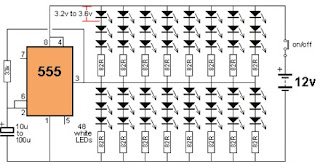
The 555 is capable of sinking and sourcing up to 200mA, but it gets very hot when doing this on a 12v supply.
This white led driver circuit shows the maximum number of white LEDs that can be realistically driven from a 555 timer . The total current was limited to about 130mA as each LED is designed to pass about 17mA to 22mA maximum. A white LED drops a characteristic 3.2v to 3.6v and this means only 3 LEDs can be placed in series.
As you can see in the circuit diagram , this electronic project circuit require few external electronic parts and is capable to drive up to 48 white LEDs from a 12 volts DC power source , utilizing few electronic components .
IC TDA7012T Mini FM Received Based on Single FM circuit with explanation
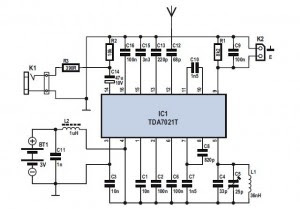
Mini FM Received Circuit
TDA7021T chip radio receiver ambit is for carriageable radios, stereo as able-bodied as mono, area a minimum of ambit is important in agreement of baby ambit and low cost. It is absolutely accordant for applications application the low-voltage micro affability arrangement (MTS). The IC has a abundance bound bend (FLL) arrangement with an average abundance of 76 kHz. The selectivity is acquired by alive RC filters.
The alone action to be acquainted is the beating abundance of the oscillator. Interstation babble as able-bodied as babble from accepting anemic signals is bargain by a alternation aphasiac system.
Part List:
R1 = 8kΩ2
R2 = 10kΩ
R3 = 390Ω
C1,C3 = 10nF
C2,C6,C9,C16 = 100nF
C4 = 33pF
C5 = 25pF trimmer (Murata type TZB4Z250AB10R00)
C7,C10 = 1nF5
C8 = 820pF C11 = 1nF
C12 = 68pF
C13 = 220pF
C14 = 47μF 10V (Nichicon UWX1A470MCL1GB 5.5mmL chip type)
C15 = 3nF3
L1 = 36nH (4 turns 0.5mm silver-plated wire, inside diameter 4mm; length 7mm)
L2 = 1μH, SMD case 0805 (fres > 300 MHz)
IC1 = TDA7021T (SMD in SO16 case)
Simple Police Siren
Tuesday, November 11, 2014
How to Build a Shake Tic Tac LED Torch
The output voltage depends on how quickly the magnet passes from one end of the slide to the other. Thats why a rapid shaking produces a higher voltage. You must get the end of the magnet to fully pass though the coil so the voltage will be a maximum. That’s why the slide extends past the coils at the top and bottom of the diagram.
The circuit consists of two 600-turn coils in series, driving a voltage doubler. Each coil produces a positive and negative pulse, each time the magnet passes from one end of the slide to the other.
The positive pulse charges the top electrolytic via the top diode and the negative pulse charges the lower
electrolytic, via the lower diode.
The voltage across each electrolytic is combined to produce a voltage for the white LED. When the combined voltage is greater than 3.2v, the LED illuminates. The electrostatics help to keep the LED illuminated while the magnet starts to make another pass.
Courtesy Light Extender
Circuit diagram:

This allows Q2 and Q3 to turn on and the courtesy lamp is activated. When the door is closed, the courtesy lamps stay illuminated and the 33µF electrolytic capacitor starts charging through the associated 1MO resistor. As the voltages rises, Q1 turns on slowly, turning off Q2 and Q3 which gradually fades out the courtesy lamp. If a lock signal from the central locking system is received, relay 1 closes and charges the capacitor instantly, so the lamp turns off immediately. Relays were used to interface to the central locking/alarm system as a safety feature, to provide isolation in case something goes wrong.
Author: Matt Downey - Copyright: Silicon Chip Electronics
Sunday, November 9, 2014
A Car Battery Monitor
Just as I was going up a hill, the lights began to dim and the engine coughed. A large semi-trailer loomed in the rear-vision mirror as I pushed the clutch in and tried to restart. My speed was falling rapidly and my lights were blacked out - I was like a sitting duck in the middle of the road, as the semi-trailer came rapidly bearing down on me. I just managed to pull the car off the road, as the semi-trailer came screaming past, missing me by inches! After calling for assistance from the NRMA, the problem was found to be a fault in the alternator, which was failing to charge the battery. The battery voltage had been falling under the heavy load of the lights and at the worst possible time, there was not sufficient power for the lights or the motor.
After the initial shock wore off, I put on my thinking cap to come up with a PIC-based solution to the problem. What was really needed was a display and a buzzer, to get my attention should the voltage fall outside a specified range. So my design criteria was set, a series of LEDs could indicate the voltage and a buzzer would also be used to warn of problems.
- Visual indication of battery voltage
- Audible warning when voltage becomes low
- Screw terminals for easy connection
- Simple and easy to build
The circuit is based on PIC16F819 18-pin microcontroller which has an analog-to-digital (A/D) input to monitor the battery voltage and outputs capable of driving LEDs directly, to keep the component count down. There are seven LEDs in all, giving a good range of voltage indication. The topmost LED, LED1, comes on for voltages above 14V which will occur when the battery is fully charged. LED2 indicates for voltages between 13.5V and 14V while LED3 indicates between 13V and 13.5V. Normally, one of these LEDs will be on. LED4 covers 12.5V to 13V while LED5 covers 12V to 12.5V. LED6 covers from 11.5V to 12V while LED7 comes on for voltages below 11.5V. These two LEDs are backed up by the piezo chime which beeps for voltages between 11.5V and 12V and becomes more insistent for voltages below 11.5V.
That might seem fairly conservative. After all, most cars will start with no troubles, even though the battery voltage might be a touch below 12V, wont they? Well, no. Some modern cars will happily crank the motor at voltages below 11V but their engine management will not let the motor start unless the voltage is above 11V. So dont think that a modern car will always start reliably. This little battery monitor could easily prevent a very inconvenient failure to start! So lets describe the rest of the circuit. The incoming supply is connected via diode D1 which provides protection against reverse polarity while zener diode ZD1 provides protection from spike voltages.
A standard 7805 3-terminal regulator is then used to provide a stable 5V to the microcontroller. The battery voltage is sensed via a voltage divider using 33kΩ and 100kΩ resistors. This brings the voltage down to within the 0-5V range for the A/D input of the PIC16F819. Port B (RB0 to RB7) of the microcontroller is then used to drive the various LEDs, with current limiting provided via the 330Ω resistor network. RB7, pin 13, drives a switching transistor for the piezo buzzer.
Software:
All the parts are mounted on a small PC board measuring 46 x 46mm (available from Futurlec). The starting point should be the IC socket for the PIC16F819, as this is easiest to mount while the board is bare. The next item can be the PC terminal block. The resistors and capacitors can then follow. Make sure the electrolytics are inserted with correct polarity.
Make sure that you do not confuse the zener (ZD1) with the diode when you are installing them; the diode is the larger package of the two.
Saturday, November 8, 2014
Telephone Number Display Circuit Diagram

The given circuit, when connected in parallel to a telephone, dis- plays the number dialled from the telephone set using the DTMF mode. This circuit can also show the number dialled from the phone of the called party. This is particularly helpful for receiving any number over the phone lines. The DTMF signal—generated by the phone on dialling a number—is decoded by DTMF decoder CM8870P1 (IC1), which converts the received DTMF signal into its equivalent BCD number that corresponds to the dialled number. This binary number is stored sequentially in 10 latches each time a number is dialled from the phone. The first number is stored in IC5A (1/2 of CD4508) while the second number is stored in IC5B and so on.
The binary output from IC1 for digit ‘0’ as decoded by IC1 is 10102 (=1010), and this cannot be displayed by the seven-segment decoder, IC10. Therefore the binary output of IC1 is passed through a logic-circuit which converts an input of ‘10102’ into ‘00002’ without affecting the inputs ‘1’ through ‘9’. This is accomplished by gates N13 through N15 (IC11) and N1 (IC12). The storing of numbers in respective latches is done by IC2 (4017). The data valid output from pin 15 of IC1 is used to clock IC2. The ten outputs of IC2 are sequentially connected to the store and clear inputs of all the latches, except the last one, where the clear input is tied to ground. When an output pin of IC2 is high, the corresponding latch is cleared of previous data and kept ready for storing new data. Then, on clocking IC2, the same pin becomes low and the data present at the inputs of that latch at that instant gets stored and the next latch is cleared and kept ready.
The similar input and output pins of all latches are connected together to form two separate input and output buses. There is only one 7-segment decoder/driver IC10 for all the ten displays. This not only reduces size and cost but reduces power requirement too. The output from a latch is available only when its disable pins (3 and 15) are brought low. This is done by IC3, IC12 and IC13. IC3 is clocked by an astable multivibrator IC4 (555). IC3 also drives the displays by switching corresponding transistors. When a latch is enabled, its corresponding display is turned on and the content of that latch, after decoding by IC10, gets displayed in the corresponding display. For instance, contents of IC5A are displayed on display ‘DIS1,’ that of IC5B on ‘DIS2’ and so on. The system should be connected to the telephone lines via a DPDT switch (not shown) for manual switching, otherwise any circuit capable of sensing handset’s off-hook condition and thereby switching relays, etc. can be used for automatic switching.
The power-supply switch can also be replaced then. Though this circuit is capable of showing a maximum of ten digits, one can reduce the display digits as required. For doing this, connect the reset pin of IC2, say, for a 7-digit display, with S6 output at pin 5. The present circuit can be built on a veroboard and housed in a suitable box. The displays are common-cathode type. To make the system compact, small, 7-segment displays can be used but with some extra cost. Also, different colour displays can be used for the first three or four digits to separate the exchange code/STD code, etc.
Dual High Side Switch Controller
Solar Panel Current Meter
Specifications
Measured Current: 0-10 Amps DC
Circuit Voltage: Will work with DC circuits at any practical voltage.
Accuracy: approximately 2%, depending on the meter movement.
Theory
The current to be measured flows through the 0.01 ohm resistor which causes a small voltage drop across the resistor. The 100 microamp meter is set up with the series 50 ohm and 500 ohm variable resistor in a voltage measurement configuration to measure this voltage drop. The 500 ohm variable resistor is used to adjust the meters full scale reading. The 50 ohm resistor limits the maximum current to the meter no matter what setting is on the 500 ohm resistor, this protects the meter from passing too much current and burning up. The series resistance of the meter, 500 ohm (or less) variable resistor and 50 ohm resistor should total 1000 ohms. Different meters may require a different variable resistor to achieve the 1000 ohm value.
Construction
Build the meter into a metal box with the meter and two connectors mounted on the outside of the box.
Alignment
Put the meter circuit in series with a known current meter such as a digital VOM meter set to measure current. Run a known current through both meters. Adjust the 500 ohm resistor until both meters read the same current. A good way to get a known current is to put a 12V lead acid battery in series with a 2 ohm 100 watt current limiting resistor. This will produce approximately 6 Amps of current. Put the two meters in series with this loop and adjust for the same reading. Beware, the resistor will get fairly hot in a short time.
Use
Connect this circuit in series with a nominal 12V or 24V solar panel array. The meter can go in either the positive or negative side of the solar panel circuit. The current flowing through the solar panel to the load will be shown on the meter.
Parts
1x 100 microamp DC meter
1x 0.01 ohm 5 W resistor
1x 50 ohm 1/4 W resistor
1x 500 ohm 10 turn variable resistor
2x banana plugs or a 2 pin screw type terminal block.
1x metal box
Acoustic Distress Beacon
Friday, November 7, 2014
Motorbike Alarm
Thereafter, if anyone attempts to get on the bike or move it, the alarm sounds for approximately15 seconds and also disconnects the ignition circuit. During parking, hidden switch S1 is normally open and does not allow triggering of mosfet T1. But when someone starts the motorbike through ignition switch S2, MOSFET T2 triggers through diode D1 and resistor R5. Relay RL1 (12V, 2C/O) energises to activate the alarm (built around IC1) as well as to disconnect the ignition coil from the circuit. Disconnection of the ignition coil prevents generation of spark from the spark plug. Usually, there is a wire running from the alternator to the ignition coil, which has to be routed through one of the N/C1 contacts of relay RL1 as shown in Fig.1 Fig.2 shows the pin configurations of SCR BT169, MOSFET BS170 and transistor BC548.
Tilt switch S3 prevents attempt to move the vehicle without starting it. Glass-and metal-bodied versions of the switch offer bounce-free switching and quick break action even when tilted slowly.
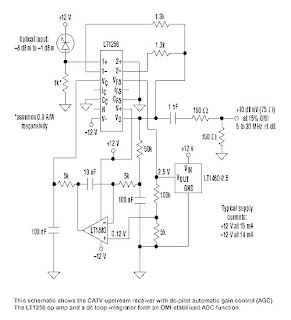

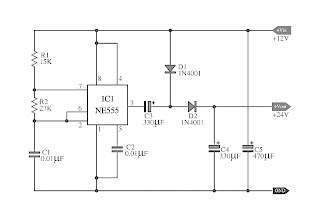










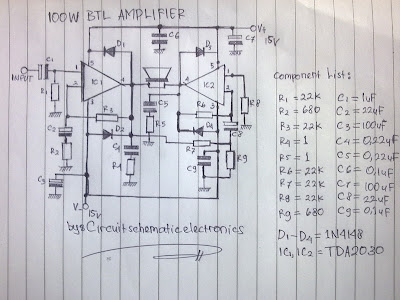

+Controller.jpg)

